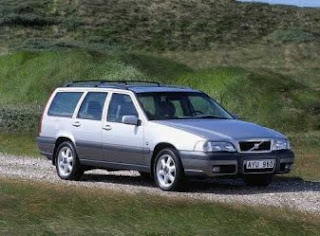A successor to the XC70 has been announced in the press release and video below. It is to be called the V90 Cross Country, thereby resurrecting the naming convention of the first generation V70 Cross Country.
Volvo Cars travels down a familiar road with coming V90 Cross Country
8 September 2016
Volvo Cars’ instrumental role in defining the adventurous Cross Country segment is widely acknowledged. With the imminent reveal of the new V90 Cross Country, the Swedish carmaker is set to cement its leading role as the most capable and comfortable premium all-roader on offer and complete its 90 Series line-up.
“Cross Country has become the true expression of a Volvo car in many peoples’ eyes. It was a winning concept from the start, perfect for the tough climate and road conditions that we experience in Sweden,” said Håkan Samuelsson, President & CEO, Volvo Car Group.
Developed in 1996, the first Cross Country estate combined functional flexibility and rugged capability. Today, 20 years later, the Cross Country segment is a familiar sight across the premium car market, providing a capable, yet comfortable driving experience.
Extreme climate capability
Designed to cope with the demanding requirements of an extreme Scandinavian climate, Cross Country models perform in all sorts of road conditions – from muddy tracks and knee-deep snow to long distance highway driving. Proving a popular choice with horse and boat owners thanks to its high ground clearance, pulling power and responsive All-Wheel Drive, Cross Country has cemented its position as a premium mainstay and a true all-weather alternative to the SUV.
“We were very careful from the very beginning to ensure that the Cross Country concept was not just an exercise in rugged styling. We placed high demands on real-world capability, and as we developed the segment we added the comfort and convenience elements that Volvo drivers have come to expect,” said Dr Peter Mertens, Senior Vice President Research & Development at Volvo Car Group.
The eagerly awaited V90 Cross Country will be revealed in mid-September.
First generation 1997 – 2000
Developed as a capable alternative to the SUV and front-wheel drive cars, Volvo Cars’ first Cross Country the V70 XC grew in popularity as old school SUVs began to morph into city jeeps. Cross Country offered a new, adventurous take on motoring that delivered a competent mix of capability, functionality and comfort. The V70 XC was an instant success, especially in the North American market.
Second generation, 2000– 2007
In 2000, the second generation V70 XC came with much bolder styling and higher ground clearance.
When Volvo's first SUV, the XC90, came in 2002, the V70 XC received a newer, more modern All-Wheel Drive system and changed its name to XC70 in order to align to its bigger brother.
Third generation, 2007 - 2016
The third generation Volvo Cross Country arrived in 2007 with added elegance and luxury. The XC70 continued to be a North American love affair, accounting for almost half of the total volume produced.
In 2014, the XC70 gained recognition around the globe as Zlatan Ibrahimovic´s car thanks to a Volvo Cars commercial featuring the Swedish footballer. Such was the impact that sales of the model grew markedly during its last years of production.
A number of photos of a disguised test car were captured:
Here are a few renderings of how the car might look:






















